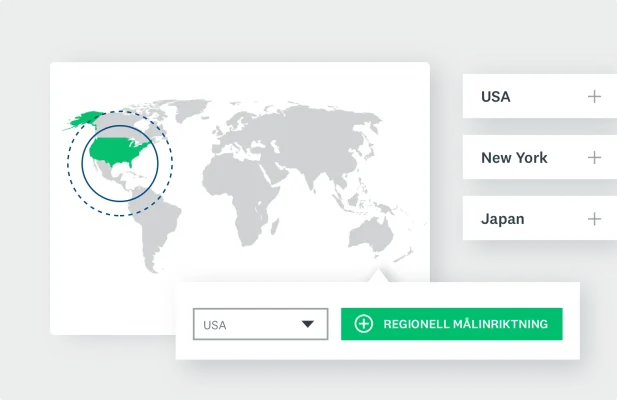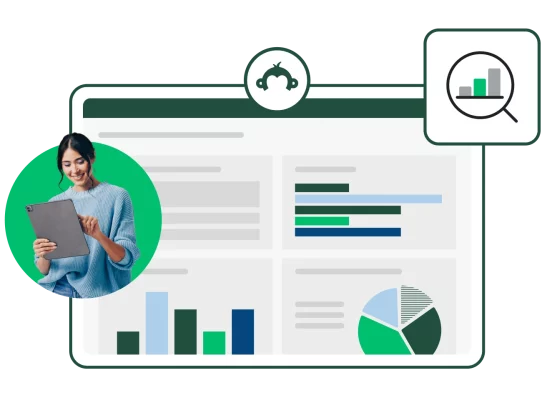Fem sorters marknadssegmentering och hur ni använder dem (med exempel)

- Marknadssegmentering innebär att en bred konsumentmarknad delas in i mindre och distinkta grupper baserat på gemensamma egenskaper.
- Marknadssegmentering är viktigt eftersom det ger företag möjlighet att rikta sig till specifika grupper mer effektivt, vilket leder till nöjdare kunder och bättre affärsresultat.
- De fem olika typerna av marknadssegmentering är demografisk, psykografisk, beteendemässig, geografisk och firmografisk segmentering.
Se kunderna som en färgsprakade mosaik, där var och en är unik men delar vissa drag med andra. Marknadssegmentering handlar om konsten att identifiera de här mönstren, gruppera kunderna utifrån deras gemensamma egenskaper och ta fram strategier som passar deras gemensamma behov och önskemål.
När ni väl har skapat grupper utifrån marknadssegment kan ni rikta reklamen mer effektivt till just dessa segment. Olika segment kan ha olika önskemål som skiljer dem åt. När företaget fokuserar på vad varje enskild grupp vill ha kan de öka engagemanget såväl som interaktionen och försäljningen.
Vad är marknadssegmentering?
Marknadssegmentering går ut på att dela upp en stor population i undergrupper utifrån vissa gemensamma faktorer. De här grupperna kan ha samma demografiska egenskaper (som ålder eller kön), geografiska plats, attityder, beteenden eller en kombination av likartade egenskaper.
Genom att skapa mindre grupper som bygger på gemensamma faktorer blir det lättare att rikta sig till rätt målgrupp.
Vet ni vilka egenskaper målmarknaden har?
Ta reda på det på några minuter med SurveyMonkeys konsumentsegmentering.
Varför använda marknadssegmentering?
Med marknadssegmentering kan företaget utveckla detaljerade profiler för varje marknadssegment. När de här segmenten har definierats tydligt skapar marknadsförarna strategier för segmenten med störst benägenhet att köpa produkterna och tjänsterna.
För att uppnå målet går marknadsförarna igenom en trestegsprocess, som förtydligar vilka människorna är och varför de köper produkter.
- Segment: Marknadsförarna delar in marknaden i kategorier som bygger på gemensamma egenskaper.
- Målgrupp: De väljer den marknad eller målgrupp som mest sannolikt kommer att köpa deras produkter.
- Position: Marknadsförarna undersöker vilka kombinationer av produkt, pris, kampanj och plats som lockar kunderna att köpa deras produkter.
Så snart marknadsförarna har identifierat sin målgrupp måste de definiera vad som särskiljer deras produkt. Är den bättre, snabbare, billigare eller mer avancerad än konkurrenternas? För att få svar på den frågan måste marknadsförarna förstå målgruppens problem och hur de skulle kunna lösa dem.
Företagen skapar konkurrensfördelar med hjälp av produktdifferentiering, som får deras produkter och tjänster att sticka ut i mängden som lösningar på köparnas problem.
Om marknadsförarna kan identifiera en målmarknad och deras problem för att skapa en produkt som löser dem är sannolikheten för att lyckas större för dem än för konkurrenterna.
Exempel på marknadssegmentering
Marknadssegmentering är det första steget mot framgångsrik produktmarknadsföring. Oavsett om företaget marknadsför sig mot konsumenter eller andra företag får de med hjälp av marknadssegment en bättre förståelse för kundernas problem och större möjlighet att lösa dem.
Alla företag segmenterar inte sina kunder på samma sätt, utan det finns flera olika sätt att göra det.
Här är tre vanliga exempel på marknadssegmentering.
Ingen segmentering
Företagen använder massmarknadsföring för att sälja sina produkter till alla med en odifferentierad strategi. Företag som säljer till exempel salt eller andra vanliga produkter som är utbytbara kanske inte lägger lika mycket pengar på att segmentera marknaden.
Begränsade segment
Företagen kan använda en eller flera snävt definierade målmarknader för att skapa en extremt fokuserad nischmarknad för specialiserade produkter. Exempel: exklusiva modeartiklar, handgjord konst eller specialtillverkade maskindelar.
Tusentals segment
Detta kallas hypersegmentering, och marknadsförarna kan ta fram ett individuellt marknadsföringsbudskap till varje kund för att utveckla ett långsiktigt förhållande. Personliga tjänster som frisersalonger och e-handelsföretag som Amazon har till exempel individanpassade rekommendationer som bygger på inköpshistorik.
Fem sorters marknadssegmentering
Oavsett om ni vill ta fram en handfull segment eller flera tusen bör företaget förstå de fem olika typerna av marknadssegmentering.
Vi tar en titt på de olika segmenteringstyperna – demografisk, psykografisk, beteendemässig, geografisk och firmografisk – samt vad de omfattar och hur de används.
1. Demografisk segmentering
Demografisk segmentering bygger på antagandet att människor med liknande egenskaper har liknande livsstilsmönster, smak och intressen som påverkar deras köpvanor. Demografisk segmentering kombineras ofta med annan segmentering för att ta fram målmarknader med störst benägenhet att köpa produkterna.
Demografi omfattar faktorer som ålder, kön, yrke, inkomst och utbildning.
Så här använder du demografisk segmentering
Fördelen med demografisk segmentering är att det är enkelt att samla in data. Olika myndighetskällor, som Statistikmyndigheten SCB, tillhandahåller data om hushåll, inkomst, utbildning och hälsa som kan användas i marknadsföringsstrategier och affärsmål.
Efter den demografiska segmenteringen kan marknadsförarna använda samma information för kundsegmentering. Med hjälp av demografi och beteenden kan de identifiera följande:
- hur stor den potentiella marknaden för en produkt är
- hur ett varumärke står sig mot konkurrenternas
- vilken demografi som mest sannolikt kommer att köpa produkten eller tjänsten
- vilka reklamkampanjer som passar målmarknaden bäst.
När demografisk segmentering kombineras med beteenden och andra variabler får ni värdefulla insikter, som hjälper er att förstå vilka kunder inom målmarknaden som kommer att köpa produkterna och hur ni når dem med rätt marknadsföringsbudskap.
2. Psykografisk segmentering
Psykografisk segmentering delar in människor i grupper baserat på deras personlighet, livsstil, sociala status, aktiviteter, intressen, åsikter och attityder. Det är ett utmärkt komplement till demografisk segmentering, eftersom det identifierar vad som motiverar människor att göra de val de gör.
Har ni sett över målmarknadens demografi på sistone?
Förändring går fort. Ta nya tag med SurveyMonkeys konsumentsegmentering.
Så här använder du psykografisk segmentering
Psykografisk segmentering är ett effektivt sätt att få en bild av kundernas problem, beteenden och attityder.
Företag använder psykografisk segmentering för att förstå:
- hur konsumenterna uppfattar deras produkter och tjänster
- vad konsumenterna egentligen vill ha och varför
- brister eller problem med befintliga produkter eller tjänster
- möjligheter till framtida engagemang
- hur de kan bli bättre på att kommunicera med målgruppen.
3. Beteendemässig segmentering
Beteendemässig marknadssegmentering beskriver steg i den idealiska kundens köpprocess. Den här typen av segmentering omfattar bland annat vad den idealiska kunden vill ha, varför de vill ha det, fördelarna de är ute efter och hur de tillgodoser sina behov.
Så här använder du beteendemässig segmentering
Företag kan använda beteendemässig marknadssegmentering för att studera B2C- och B2B-marknadssegment. När de förstår varför kunderna köper något kan de också rikta sina marknadsföringsbudskap bättre. Beteenden kan omfatta:
- Orsak till inköpet: Letar köparna efter det bästa priset, det bästa betyget, säkerhetsrisker eller andra villkor?
- Händelse eller evenemang: Köper konsumenterna något inför semestern eller en högtidsdag? Försöker B2B-köparna spendera sin budget innan året är slut?
- Produktfördelar: Vill köparen ha den senaste tekniken, den säkraste produkten eller vara först med att köpa den senaste produkten?
- Var på köpresan kunden är: Vill köparen veta mer inför ett framtida köp? Eller vill de prova varumärket för första gången?
- Engagemangsnivå: Är köparen ett superfan som vill ha den senaste produkten?
När marknadsförarna vet varför konsumenter eller företag köper deras produkter kan de också utveckla segmenteringsstrategier som tar hänsyn till de beteendena.
4. Geografisk segmentering
Med geografisk segmentering kan marknadsförarna gruppera människor baserat på var de bor, arbetar eller reser.
Platsen har en avgörande betydelse för köpvanor som marknadsförarna kan använda för att utveckla budskapet. Marknadsförarna kan använda olika typer av variabler för geografisk segmentering, till exempel land, region, län, kommun, stad, klimatzon eller postnummer.
Kultur och populationstäthet (stad eller landsbygd) är också viktiga variabler att ta med i marknadsundersökningar. De här platsvariablerna påverkar vilka problem människor har i ett område och hur marknadsförarna kan lösa dem.

Så här använder du geografisk segmentering
Var en person bor kan påverka allt från vilken mat de äter till vilken bil de kör. Företag kan använda geografisk segmentering för att avgöra vilka produkter som passar kunderna bäst.
Ett exempel på geografisk segmentering är att marknadsföra växter efter klimatzon. Perenner som går bra att odla i södra Sverige kanske inte klarar vintrarna i norra Sverige. Om marknadsförarna vet var människorna de riktar sig till bor kan de identifiera växter och andra produkter som passar klimatet på den platsen.
Det kan också vara så att ett klädföretag rekommenderar dunjackor till någon som bor i en kallare region. Genom att anpassa vilka produkter ni marknadsför mot en kund utifrån var de befinner sig kan ni påverka deras köpvilja avsevärt.
Läs också: En komplett guide till segmenteringsenkäter
5. Firmografisk segmentering
För B2B-marknadsförarna motsvarar firmografisk segmentering det som B2C-marknadsförarna kallar demografisk segmentering. Den firmografiska segmenteringen kastar ljus över egenskaperna hos verksamhetens målmarknad, bland annat bransch, antal anställda, juridisk ställning, företagsstorlek, kassalikviditet och andra affärsvariabler.
Miljoner människor flyttar varje år. Har den geografiska profilen för målmarknaden förändrats? Ta reda på det på några timmar med SurveyMonkeys konsumentsegmentering.
Så här använder du firmografisk segmentering
Med firmografisk segmentering får marknadsförarna information som gör att de kan förstå styrkorna och svagheterna hos de olika företagen på målmarknaden. De fokuserar på faktorer som resultat, vinst och tillväxttrender för att se om marknadssegmentet växer eller är på nedåtgående.
Det här är några exempel på firmografiska data:
- Näringsgrensindelning: SNI, standard för svensk näringsgrensindelning, i Sverige.
- Ägarskap och juridisk ställning: Ägarskapsförhållanden, till exempel enskild firma, handelsbolag, aktiebolag, kommanditbolag och föreningar.
- Verksamt i antal år: Hur länge ett företag varit verksamt kan vara en god indikator på dess soliditet och branscherfarenhet.
- Antal anställda: Antalet anställda visar hur stort företaget är.
- Plats: Platser kan omfatta kontor, fabriker och butiker.
- Kunder och produkter: Vilka produkter företaget tillverkar eller säljer och vilken målgrupp de har.
- Marknadsstorlek: Hur stor marknaden är och vilka konkurrenterna är.
Fördelar med marknadssegmentering

Marknadssegmentering är grunden för att lyckas med produktkoncept, lanseringar, marknadsföringsbudskap, annonser och andra viktiga marknadsföringsaktiviteter.
Företag investerar betydande resurser i att förstå sina idealkunders problem så att de kan lösa dem med hjälp av värdefulla produkter och tjänster. Vilka är fördelarna med att investera tid och pengar i marknadssegmentering?
Bättre marknadsföringskampanjer
Företag spenderar miljarder dollar på marknadsföring och reklam när de vet exakt vilken målgruppen är och vad de vill ha. Marknadsförarna samlar nu in enorma mängder data om målgrupper för att försäkra sig om att budskapet attraherar rätt kunder, vid rätt tidpunkt, till rätt produkter.
Enkäter är ett riktigt bra sätt att testa marknadsföringsbudskap och ta reda på om de tilltalar målgruppen. Marknadsförarna börjar med en hypotes om hur de tror att enkätdeltagarna kommer att reagera. Med hjälp av enkätresultatet kan de ta fram bättre budskap och mer framgångsrika kampanjer.
Utveckla nya produkter som träffar rätt
Även om ett företag har bra idéer om nya produkter, så måste de kontrollera om de idéerna löser några problem för målgruppen. Utan marknadssegmentering slösar de bara tid och pengar på produkter som låter bra, men inte säljer.
Med hjälp av enkäter kan de ta pulsen på målmarknaden. Inom ett par timmar kan företagen få veta om:
- de löser ett problem för målmarknaden
- en eller flera av deras idéer är en klar vinnare
- produktkonceptet har rätt funktioner, förpackning och logotyp
- köparna kommer att köpa produkten och vilket pris de är villiga att betala.
Med rätt svar från en väl avgränsad målmarknad kan företagen fokusera på framgångsrika produkter som deras målgrupp köper.
Med SurveyMonkeys lösning för koncepttestning får du veta om den där nya produktidén är en vinnare eller inte. Skaffa ett poängkort för produktresultat med branschens referenspunkter.
Identifiera nya trender och möjligheter
Trender förändras snabbt. Sociala medier kan ge insikt i nya kundbeteenden, men marknadsförarna vet inte om de beteendena är något att satsa på utan att mäta dem.
Att förstå målmarknadens beteende är grunden för marknadssegmentering. Efterhand som nya trender tillkommer måste marknadsförarna ta reda på vilka som utgör nya möjligheter och vilka som kommer att försvinna lika fort som de dök upp.
Marknadsförarna ansvarar för att identifiera nya kundproblem, definiera nya marknadsföringsbudskap och testa nya produktkoncept. För att kunna identifiera nya möjligheter måste de testa målgrupperna ofta för att få nya insikter och kontrollera om de befintliga produkterna fortfarande tilltalar kunderna.
Förse andra avdelningar med information
Marknadssegmentering innehåller en robust datauppsättning som omfattar kunddata som andra avdelningar kan använda för att företaget ska lyckas bättre. I B2B-företag har försäljnings- och marknadsföringsavdelningarna ofta ett nära samarbete, där säljarna är beroende av att marknadsförarna tar fram kvalificerade säljuppslag som genererar större intäkter.
Den avdelning som ansvarar för att prissätta produkter behöver också marknadsdata och data om konkurrensläget för att kunna göra sitt jobb så att ni förblir konkurrenskraftiga. Och ingen inom tillverkningen vill jobba över för att den ökande efterfrågan leder till att det plötsligt behövs 100 000 artiklar till, och därför är det viktigt att dela information om köptrender så att produktionen kan anpassas i tid.
Marknadssegmenteringsdata är inte avsedda enbart för marknadsföringsteamet. De bör delas så att alla i företaget kan ge kunderna ännu bättre service.
Bygga upp förtroende för varumärket
Företagen vill göra mer än att bara sälja produkter till målgruppen. De vill skapa en relation med kunderna, så att de fortsätter att köpa produkterna. När kunderna känner till, gillar och fortsätter att köpa ett företags produkter har företaget skapat förtroende för varumärket.
Med marknadssegmentering identifierar du vilken målgrupp som är mest benägen att köpa inte bara en gång, utan även i framtiden. Genom att skapa en varumärkesidentitet som kunderna uppskattar kan företagen öka varumärkesmedvetenheten och bygga upp ett ömsesidigt förtroende med målmarknaden. De koncentrerar sig på det förtroendet och tar fram marknadsföringsbudskap, nya produkter, värdefullt innehåll och aktuell information, vilket skapar en kundupplevelse som lockar konsumenter och B2B-företag att komma tillbaka och handla igen.
Med hjälp av marknadssegmentering kan marknadsförarna förstå idealkundens problem och beteenden för att ta fram lösningar som bidrar till att skapa ett långsiktigt förtroende för varumärket som båda parterna har nytta av.
Vilken sorts relation har företaget till målgruppen?
Ta reda på vad som krävs för att skapa förtroende för varumärket med SurveyMonkeys varumärkesspårare.
Segmentera data med SurveyMonkey
Företag som förstår marknadssegmentering kan skapa mer engagerande och skräddarsytt innehåll som alla kunder gillar. Att segmentera målgruppen är avgörande för att leverera effektivt marknadsföringsmaterial och öka engagemanget hos kunderna.
Läs mer om hur ni segmenterar data med SurveyMonkey och skapar detaljerade kundgrupper som ni kan kommunicera extremt effektivt med. Registrera dig idag så att du kan komma igång med kundsegmenteringen.
Kom igång med marknadsundersökningar
Global enkätpanel
Samla in marknadsdata genom att skicka enkäten till ett representativt urval.
Expertlösningar
Testa marknadsföringsmaterial eller produktkoncept med automatiska metoder för analys och rapportering.
